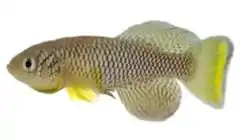Nothobranchius furzeri
Nothobranchius furzeri, the turquoise killifish, is a species of killifish from the family Nothobranchiidae native to Africa where it is only known from Zimbabwe and Mozambique.[2] This annual killifish inhabits ephemeral pools in semi-arid areas with scarce and erratic precipitations and have adapted to the routine drying of their environment by evolving desiccation-resistant eggs that can remain dormant in the dry mud for one and maybe more years by entering into diapause.[3]
| Turquoise killifish | |
|---|---|
 | |
| Male Nothobranchius furzeri GRZ (from Gonarezhou National Park) | |
| Scientific classification | |
| Domain: | Eukaryota |
| Kingdom: | Animalia |
| Phylum: | Chordata |
| Class: | Actinopterygii |
| Order: | Cyprinodontiformes |
| Family: | Nothobranchiidae |
| Genus: | Nothobranchius |
| Species: | N. furzeri |
| Binomial name | |
| Nothobranchius furzeri R. A. Jubb, 1971 | |
Among vertebrates, the species has the fastest known sexual maturity – only 14 days after hatching.[4][5] Due to very short duration of the rain season, the natural lifespan of these animals is limited to a few months[6][7] and their captive lifespan is likewise short. More specifically, they are able to live 1–5 months in the wild (with most only living up to 2 months[7]) and 3[8] to 16[9] months in captivity depending on the strain and environment. Turquoise killifish are the shortest-lived vertebrate kept in captivity[10] making them an attractive model system for ageing and disease research.[11] Tandem repeats comprise 21% of the species' genome, an abnormally high proportion, which has been suggested as a factor in its fast ageing.[12][13] Their captive diet consists mostly bloodworms and there are current efforts to replace bloodworms by pelleted diets.[14]
This species can reach a total length of 6.5 cm (2.6 in).[2]
The species name is derived from that of the discoverer Richard E. Furzer of Rhodesia.[15]
References
- Nagy, B.; Watters, B. (2019). "Nothobranchius furzeri". IUCN Red List of Threatened Species. 2019: e.T63305A99447871. doi:10.2305/IUCN.UK.2019-3.RLTS.T63305A99447871.en. Retrieved 20 November 2021.
- Froese, Rainer; Pauly, Daniel (eds.) (2014). "Nothobranchius furzeri" in FishBase. February 2014 version.
- Reichard, Martin; Polačik, Matej (2019-01-08). "Nothobranchius furzeri, an 'instant' fish from an ephemeral habitat". eLife. 8: e41548. doi:10.7554/eLife.41548. ISSN 2050-084X. PMC 6324871. PMID 30616713.
- Milius, Susan (2018-08-06). "This killifish can go from egg to sex in two weeks". Science News. Retrieved 2018-08-08.
- Vrtílek, Milan; Žák, Jakub; Pšenička, Martin; Reichard, Martin (August 2018). "Extremely rapid maturation of a wild African annual fish". Current Biology. 28 (15): R822–R824. doi:10.1016/j.cub.2018.06.031. ISSN 0960-9822. PMID 30086311.
- Vrtílek, Milan; Žák, Jakub; Polačik, Matej; Blažek, Radim; Reichard, Martin (2018-03-19). "Longitudinal demographic study of wild populations of African annual killifish". Scientific Reports. 8 (1): 4774. doi:10.1038/s41598-018-22878-6. ISSN 2045-2322. PMC 5859278. PMID 29555942.
- Žák, Jakub; Vrtílek, Milan; Polačik, Matej; Blažek, Radim; Reichard, Martin (2021). "Short-lived fishes: Annual and multivoltine strategies". Fish and Fisheries. 22 (3): 546–561. doi:10.1111/faf.12535. ISSN 1467-2979. S2CID 234048965.
- Valdesalici, Stefano; Cellerino, Alessandro (2003-11-07). "Extremely short lifespan in the annual fish Nothobranchius furzeri". Proceedings of the Royal Society of London. Series B: Biological Sciences. 270 (suppl_2): S189-91. doi:10.1098/rsbl.2003.0048. ISSN 0962-8452. PMC 1809958. PMID 14667379.
- Žák, Jakub; Reichard, Martin (February 2021). Gaillard, Jean‐Michel (ed.). "Reproductive senescence in a short‐lived fish". Journal of Animal Ecology. 90 (2): 492–502. doi:10.1111/1365-2656.13382. ISSN 0021-8790. PMID 33159690. S2CID 226275515.
- Cellerino, Alessandro; Valenzano, Dario R.; Reichard, Martin (May 2016). "From the bush to the bench: the annual Nothobranchius fishes as a new model system in biology". Biological Reviews. 91 (2): 511–533. doi:10.1111/brv.12183. ISSN 1464-7931. PMID 25923786.
- Harel, I.; Benayoun, B. R. N. A.; Machado, B.; Singh, P. P.; Hu, C. K.; Pech, M. F.; Valenzano, D. R.; Zhang, E.; Sharp, S. C.; Artandi, S. E.; Brunet, A. (2015). "A Platform for Rapid Exploration of Aging and Diseases in a Naturally Short-Lived Vertebrate". Cell. 160 (5): 1013–26. doi:10.1016/j.cell.2015.01.038. PMC 4344913. PMID 25684364.
- Treangen, T. J.; Salzberg, S. L. (2011). "Repetitive DNA and next-generation sequencing: Computational challenges and solutions". Nature Reviews Genetics. 13 (1): 36–46. doi:10.1038/nrg3117. PMC 3324860. PMID 22124482.
- Willemsen, David; Cui, Rongfeng; Reichard, Martin; Valenzano, Dario Riccardo (2020-09-01). Kapahi, Pankaj; Tyler, Jessica K; Clark, Nathan (eds.). "Intra-species differences in population size shape life history and genome evolution". eLife. 9: e55794. doi:10.7554/eLife.55794. ISSN 2050-084X. PMC 7462614. PMID 32869739.
- Žák, Jakub; Dyková, Iva; Reichard, Martin (December 2020). "Good performance of turquoise killifish (Nothobranchius furzeri) on pelleted diet as a step towards husbandry standardization". Scientific Reports. 10 (1): 8986. doi:10.1038/s41598-020-65930-0. ISSN 2045-2322. PMC 7265286. PMID 32488062.
- Christopher Scharpf; Kenneth J. Lazara (31 May 2019). "Order CYPRINODONTIFORMES: Families APLOCHEILIDAE and NOTHOBRANCHIIDAE". The ETYFish Project Fish Name Etymology Database. Christopher Scharpf and Kenneth J. Lazara. Retrieved 4 September 2019.
External links
- Nothobranchius furzeri on WildNothos - various information and photographs of this species
- NCBI taxonomy database
- NFIN - The Nothobranchius furzeri Information Network
- In Short-Lived Fish, Secrets to Aging (Carl Zimmer, New York Times)
- Nothobranchius furzeri in ageing research
- Maintenance, breeding & conservation of killifish
- Nothobranchius furzeri information
- Prachtgrundkärpflinge (German)
